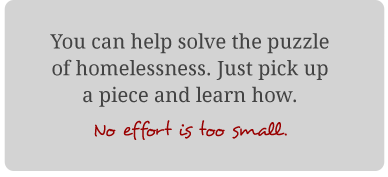Facts
On any given night, there are approximately 2,001 people, including those in families, experiencing homelessness in Charlotte-Mecklenburg County.1
Our community needs over 16,000 affordable rental housing units, with or without services, to prevent and end homelessness.2
Homeless families tend to be younger, headed by single mothers, and have children under the age of six.3
On any given night, over one-third of people experiencing homelessness in our community are part of a family with dependent children.4
Veterans are about 50 percent more likely than the general population to experience homelessness.5
Soldiers who served in Vietnam and post-Vietnam era conflict are the veterans at the greatest risk of homelessness.6
An estimated 119 survivors of domestic violence are homeless in Charlotte-Mecklenburg on any given night.7
Young adults (ages 18 to 30) represent a growing segment of the homeless population.8
Low wages, under-employment, and high rental costs prevent the estimated nine percent of homeless individuals who are employed from obtaining stable housing.9
An estimated ten percent of the homeless population experience long-term homelessness in addition to their disabling condition.10
Over the course of an academic year, there are approximately 4,770 children in the Charlotte-Mecklenburg school system who report being homeless, living in motels or doubled-up.11
Footnotes
1, 4, 7Charlotte-Mecklenburg Point in Time Count. (2015). Collected for night of January 29, 2015.
6Kasprow, W.J., Rosenheck, R.A., DiLella, D., Cavallaro, L.A., and & Harelik, N. (2009). Health Care for the Homeless Veterans Programs: Twenty-sSecond Annual Report. Washington, DC: Department of Veterans Affairs.

